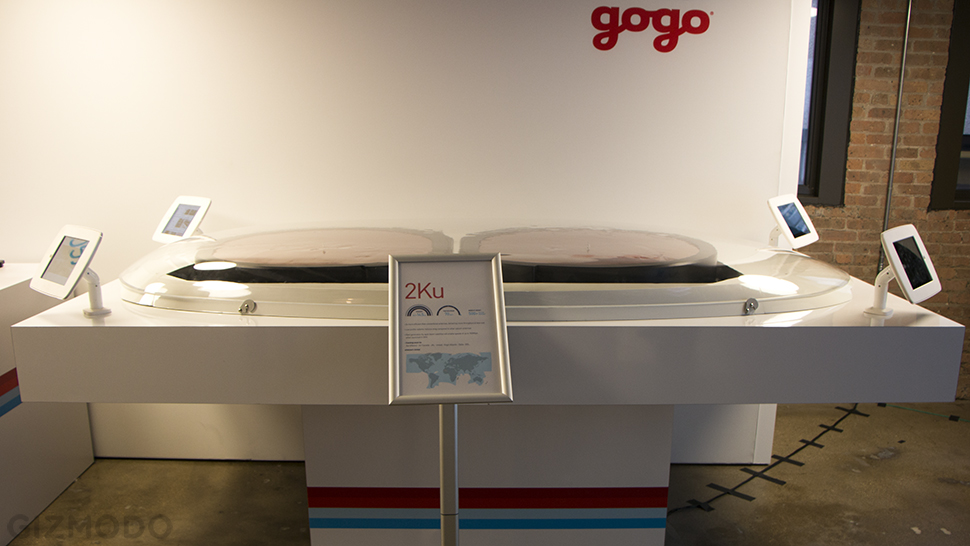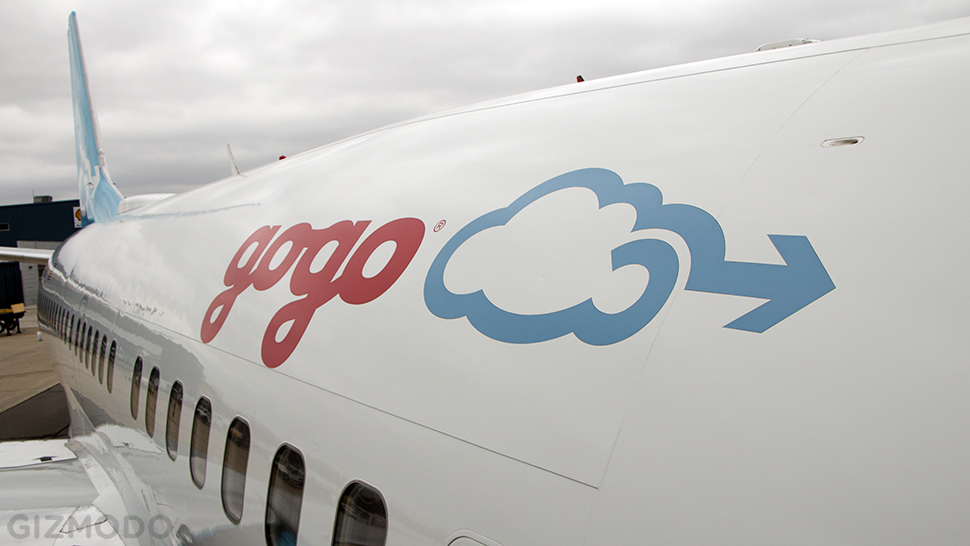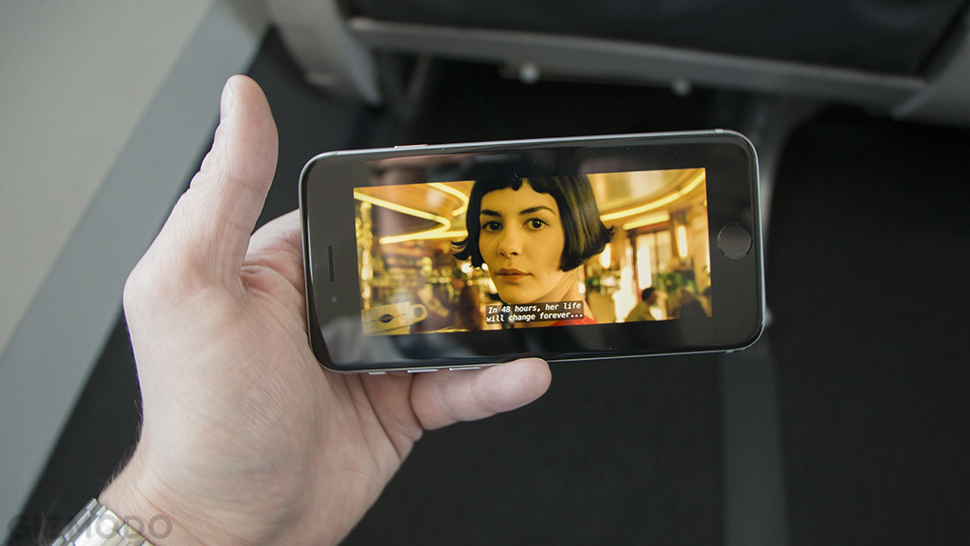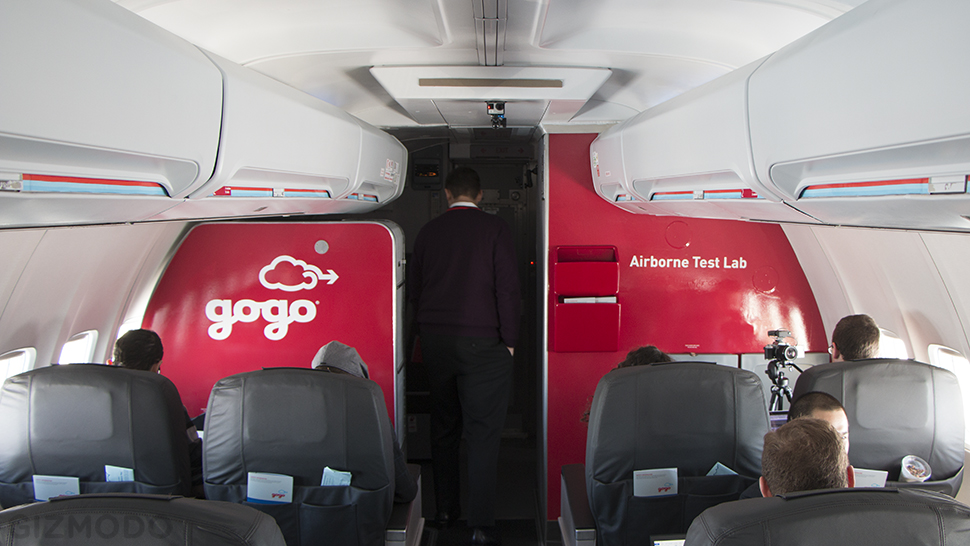We were cruising at around 1000ft, somewhere above the Midwest, when two pizza-shaped antennas on top of the plane finally connected with the satellite. Within seconds, I was streaming a movie on Netflix in full HD while the man next to me waved at his iPhone.
Our in-flight Wi-Fi, I realised, was faster than my apartment’s internet. But it was only a test. This was no ordinary plane.
A Press Trip
A few weeks ago I got a strange invitation. Gogo, the pioneer of in-flight Wi-Fi, wanted to fly me to Chicago so that I could test the company’s latest technology. I’d read about the so-called 2Ku system months before, when I was writing a story about how Wi-Fi worked on planes, and it sounded impressive. Gogo claims that its new dual antenna, satellite-based setup can offer peak speeds of 70-megabits-per-second. That’s fast enough to support both zippy web browsing and streaming from services that are typically impossible to use during a flight.
I said yes to the junket, but I was a little confused. Would I get to fly to Chicago on a plane already equipped with 2Ku? That seemed unlikely, since the system won’t roll out until 2016. (Aeromexico was the first airline to commit.) Subsequent planning revealed that I’d fly to Chicago on a very ordinary United jet, and we’d be escorted to a small airport in Gary, Indiana, where Gogo keeps a 737 test plane in a hangar. For the test, we’d fly in a circle above Lake Michigan and try out the company’s new internet.
Gogo paid for my travel and put me up in a hotel. I flew out of Laguardia and used the United-branded in-flight Wi-Fi on the way to Chicago. It was as terrible as you’d expect, and I later learned that the airline uses Gogo technology. Of course, this was not the test. This was the reality of connecting to the internet from 30,000ft. Amazing, but wildly imperfect.
A Quick History of In-Flight Wi-Fi
Gogo was one of the first companies to start connecting planes back in the early ’90s, when it was called Aircell. At the time, of course, Wi-Fi was still a few years away, and the company was focused on putting phones in the backs of headrests, a lofty goal given that cell phones were the size of bricks.
The basic principle that guided the early days of Aircell still powers the majority of Gogo’s in-flight Wi-Fi networks. Carefully positioned cell towers on the ground beam a signal up to planes. This so-called air-to-ground (ATG) technology and its successor, ATG-4 technology, can’t support very much bandwidth and is prone to outages. As any given flight moves across the country, it connects to new towers, which can briefly cause the internet to cut out. As the “G” in the name suggests, the ATG systems won’t work on flights over bodies of water.

Here’s one of Gogo’s (rather bulky) pivoting antennas for Ka-band satellites
A few years ago, Gogo and others started offering internet service through pivoting antennas on the tops of planes that would connect to Ka-band satellites. The latest in-flight Wi-Fi technology connects to Ku-band satellites, the same ones that the International Space Station uses for communications. Satellite connections are slightly more prone to weather-related interruptions, but offer far more bandwidth, than ATG connections.
Gogo’s new 2Ku technology is supposed to be the fastest in-flight Wi-Fi in the world. With dual fixed antennas — one for uploads, one for downloads — that sit under a low profile randome, the system is the Cadillac version of existing satellite solutions. Since the antennas don’t have to swivel to find a satellite, the whole system is low-profile and aerodynamic. This is a big plus for airlines, which have to shoulder the extra fuel costs involved in strapping stuff to the outsides of their planes.

And here’s the fancy new 2Ku setup, including the sleek randome
A Glimpse Into the Future
Before my trip to Chicago, I’d never been on a private plane. Heck, I’d never been to a private airport. So when we walked into the tiny terminal in Gary, I was curious about how everything worked.
A pack of journalists and I arrived at the tiny terminal and slid through a metal detector before stepping onto the tarmac. It was a dangerously windy day, so I kept my head down as we walked up the stairs and onto Gogo’s 737. On board, a man flanked with wires stared at a pair of laptops, presumably to monitor the Wi-Fi, which worked just fine while we were on the ground.

I found my way to a first class seat and braced for takeoff. The ride up to the altitude where we’d be able to connect to the Ku satellites was a bumpy one. Once we broke through the clouds, though, sunlight streamed in the windows, and we were prompted to start our speed tests. I recall someone urging us to break the Wi-Fi, and I’m quite sure the geeks around me did their very best. I just wanted to see what I could do that I couldn’t normally do on any lesser in-flight Wi-Fi.
The answer, I learned, was not much. Steaming Netflix worked great. YouTube videos played without a hitch. Ditto for Spotify songs. It was only after I saw my neighbour’s FaceTime experiment that I tried to call my mum. In a sense, this was the most basic test of Gogo’s technology, a glimpse back into the company’s early days when Aircell charged an arm-and-a-leg for excited travellers to call their families and crow, “I’m calling you from an aeroplane!”

Imagine telling your eight-year-old self that one day you’d be able to watch movies on the internet on your pocket computer on an aeroplane
It didn’t work. I called my mum, who’s too often the victim of my telecom tests. She heard me say that “I’m calling you from an aeroplane!” line, and I heard her fine. But then reality set in, and the “Can you hear me now?” chorus began.
From conducting my own speed tests and talking with other journalists on the flight, a tough truth became clear. Any airline — and even Gogo itself — is compelled to set bandwidth limits to keep the network operational. On our flight, that meant throttling the upload speeds so much that you could suck data up from the internet, but it was tough to send anything out.
When people are flying, it’s much more likely that they want to stream a movie or send an email than place a Skype call. Download speeds didn’t come close to the 70 Mbps Gogo advertised. (I later learned that the company had capped download speeds at 25 Mbps, the government’s official minimum for broadband.) The uploads speeds struggled to hit 1 Mbps. That ruined my phone call, but it didn’t necessarily ruin the test.

Notice the GoPro mounted on the ceiling of the test plane?
As we descended back into the clouds and the connection switched from pinging satellites to pinging towers on the ground, the streaming stuttered and reality set in. In-flight Wi-Fi still feels like magic to me, but simple logistical challenges demand limitations. If everyone on your flight is streaming Netflix or placing FaceTime calls, the network will max out.
That said, it’s hard for me to offer up my experience as a standard. I flew on Gogo’s private plane and used its particularly calibrated Wi-Fi. A Gogo employee later explained that different airlines could configure their own networks in different ways. So will the first Aeromexico passengers to use the 2Ku technology have the same experience as me? No idea.
A Cautionary Tale
The weather was bad when we were landing. The wings lurched from side-to-side, and the pilot later told me he was battling 71km-per-hour crosswinds. A small army of Gogo representatives quickly shuttled us from the runway and into a hanger.
Back at Gogo headquarters, we got a peek inside the lab and the company’s crazy control center. We heard about how Gogo’s new offices were in the same building as Twitter, and the startup vibes — yes, foosball was spotted — were strong.
The next morning, my flight was delayed indefinitely and I needed to get some work done at the airport. But the Boingo-powered network at O’Hare barely worked. Boingo, like Gogo, offers Wi-Fi service in particular locations, each of which have their own sets of constraints. O’Hare was busy with weather delays when I was there — the wind only got worse — and I can only assume that the network was too crowded.
I’m just as quick to complain about shitty connectivity as the next person. But I also dream of a scenario when we can confront a bad connection with the option for a better one. If you’re on a Gogo-powered flight, you’re going to have to use Gogo. Unless you’re flying from Mexico to Japan, there’s a very slim chance you’re going to enjoy 2Ku technology. But even if you’re just taking a jaunt from Laguardia to O’Hare, you have to take what you can get.
So be mindful of the full picture the next time you sign online from the sky. Gogo’s making progress, and it’s new technology is undeniably impressive. My hopeful curiosity, however, begs to know which of its few competitors can make in-flight Wi-Fi even better.
Illustration by Tara Jacoby
